Curitiba, Brazil: The Roads Not Taken
By Stephen Leahy
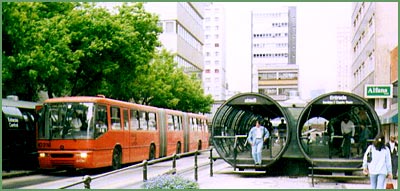
Stuck in a traffic jam? Choking on car fumes? Then take the next exit and head south past the equator to the city of Curitiba, Brazil, where you can board a bus to a public transit utopia. |
By the year 2025, two-thirds of the planet's population will live in cities, according to the United Nations. And almost all of this growth - a staggering 90 percent - will take place in countries of the developing world.
Third World cities usually conjure up images of traffic and pollution, poverty and shantytowns. But the remarkable city of Curitiba in southern Brazil is trying to paint a different picture. This mid-sized city of just over one-and-a-half million has become a Mecca for urban planners, transit officials and environmentalists the world over.
Cities as far flung as Cape Town, Santiago, Lagos, New York, Toronto, Montreal, Amsterdam and Bogota have come to learn how Curitiba fought the car congestion and pollution nightmares that haunt many, if not most, of the world's cities.
What's even more remarkable is that by most standards, Curitiba is a poor city. Its annual per capita annual income is under $3,000 (all figures in U.S. dollars). Yet polls show that residents of Curitiba love their city and wouldn't want to live anywhere else. Visitors call it one of the most liveable cities anywhere.
The story of Curitiba's transformation into a self-styled 'Capital of Ecology' begins in the late 1960s when the city of then 360,000 faced a population growth boom, like other cities in Latin America.
Curitiba was industrializing rapidly, levelling the old to make way for the modern. And like most cities, it was suffocating on its own traffic.
The solution, of course, was to build more roads.
So in a scene repeated hundreds of times the world over, the narrow, main street, and many of its magnificent turn-of-the-century buildings, were to be obliterated by a modern expressway. But in 1971, a young architect and newly-minted mayor by the name of Jaime Lerner thought the unthinkable.
He wanted to stop the construction and instead create Brazil's first pedestrian mall. However, not even the shopkeepers on the old street were in favour; how would people shop if they couldn't drive their cars?
Lerner, who had trained in Paris, believed that once people experienced a pedestrian mall they'd love it. Over one weekend Lerner pushed the public works department to rip up the pavement and put in cobblestones and flowerbeds.
By Monday afternoon the shopkeepers wanted the mall extended.
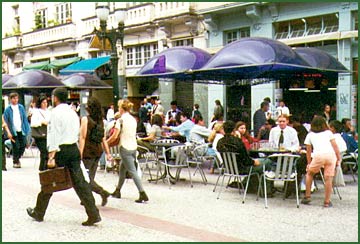
Today, Curitiba, with 1.6 million people, has car ownership levels comparable with similar-sized Toronto but has 49 blocks of the city closed to traffic.
Seventy-five percent of all city travel is done by transit - the world's highest usage. But Curitiba didn't ban cars. Over two decades it gradually made transit cheaper, faster and more convenient than driving.
Instead of spending money on that huge overpass, the Lerner administration invested in public transit. And in Curitiba, that meant buses.
Modern transit usually means subways or light rail trains. But all Curitiba could afford was a short light rail line that would do little to solve the overall traffic problem. Buses were the only way to go - but they would only work if they weren't stuck in traffic. So the local government set out to create a very fast transit system based on buses.
This idea has become known worldwide as Bus Rapid Transit (BRT).
Planners decided that existing roads would work just fine and reallocated them in groups of three: one avenue for traffic into the city, one avenue for traffic out, and one avenue for a two-way bus-only road called a canaleta.
There are five groups of these three parallel avenues that radiate like spokes of a wheel from the city centre, extending over 20 kilometres. These main roads are connected to common bus lines called interbairros that run in four widening circles to form a spider's web that connects all sectors of the city.
To minimize delays, bus stops are spaced no closer than three kilometres apart along much of this spider-web-like network. And to streamline the boarding process at the most crowded bus stops, attractive steel and acrylic tube stations are built level to the buses and designed to fit their doors. Fare is collected at the tube station's turnstile, rather than on the bus.
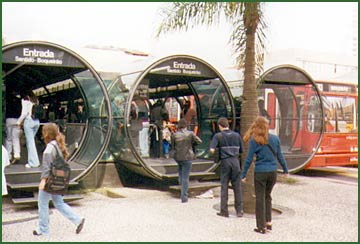
The tubes allow eight people to move in or out of the bus per second, four times the rate of conventional bus stops. Buses also have traffic-signal priority. Signals remain green or turn green a few seconds early for them so they can run from station to station mostly without stopping - just like a subway.
Finally, to handle the huge throngs of passengers riding Curitiba's BRT, the most popular routes use huge articulated buses with three coach cars that carry as many as 270 passengers. Inside and out they look and act like subway trains, carrying some 23,000 passengers per hour, better than the actual subway in Rio de Janeiro.
This comfort and swiftness has earned the express lines the nickname ligeirinho (swift ones) - as well as national and international recognition.
Going one step further, many of these buses now run on a 'green' fuel made up of 89.4 percent diesel, 8 percent alcohol and 2.6 percent soybean. This has reduced particulate emissions by 43 percent and even created some local jobs in agriculture and processing.
At the opposite end of the scale, neighbourhood mini-vans feed conventional bus routes which, in turn, feed the trunk lines. All transfers within the seamless system are free. Curitiba Transit offers one standard rate for all trips regardless of length, which benefits the poor who live on the fringes of the city and travel farther to make a living.
Altogether, the system's 1,900 buses make 14,000 trips a day, serving more than 1.9 million riders - more than New York City.
To get that kind of passenger traffic, the city also changed its zoning laws to focus commercial and residential growth around these bus corridors, reducing the pressure to expand outward. High-density apartment buildings were encouraged along these main thoroughfares.
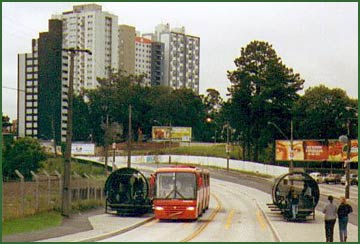
Stretches of land along rivers were put off limits to builders and made into parks, a practical option that has also eliminated economic loss from flooding. This rezoning, together with other efforts to protect natural areas and build parks, increased the area of green space per person 100-fold over 20 years.
All that green space also created room for 150 kilometres of bike trails that wind their way past parks and protected heritage buildings.
But perhaps the most surprising fact about Curitiba's mass transit system is that it was cheap.
Most of it cost only about $200,000 per kilometre to install, one-five-hundredth the cost of a subway, which internationally averages about $100 million per kilometre.
As a result of the low cost, the city was able to create a dense transit network where passengers can travel anywhere in the system for about 35 cents.
And before anyone dismisses Curitiba Transit as a grand public charity scheme, it should be pointed out that the system even makes a profit. Fast, comfortable - no bus is older than three years - this mass transit system receives no subsidies and actually makes money.
Private companies buy the buses and the city assigns the routes, sets fares and pays each contractor by kilometre travelled. The city has paid only for the roads, lighting, bus stops and staff to monitor the bus companies. It's a public-private partnership that works.
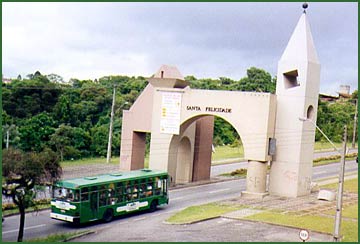
Commuting by transit has risen from 7 percent in the 70s to about 75 percent today. Air pollution has declined, and overall fuel consumption dropped by 25 percent even as the city tripled in population. The city wins awards nearly every year from groups like the International Institute for Energy Conservation.
Curitiba isn't a perfect 'eco-city.' Its problems include favelas - shantytowns of 300,000 poor inhabitants ringing the city. But the city enjoys a quality of life that is the envy of much of Brazil. Industry, including ironically, foreign auto manufacturers BMW, Chrysler and Renault are attracted to its excellent quality of life.
Other cities are naturally following Curitiba's example.
Quito, Peru and Bogota, Columbia are just two examples, notes Lloyd Wright, a transit expert with The Institute for Transportation and Development Policy (ITDP). The ITDP promotes environmentally sustainable and equitable transportation policies and projects worldwide.
Bogota, a city of seven million, now has 41 kilometres of a TransMilenio BRT system. The articulated buses in dedicated lanes have become the world's busiest bus system in less than two years.
Already car traffic has dropped 10 percent. Three hundred kilometres of dedicated bike lanes - the most in the world - has led to a 900 percent increase in bike ridership. And as Bogota weans itself off the automobile, they've started car-free days on Sundays, holidays, and even selected workdays.
The beautiful, historic city of Cuenca, Ecuador, also wants to follow Curitiba's example. Cuenca has a population of 250,000 people nestled in the Andes, and like many urban areas in developing countries, transportation was unregulated with private operators fighting for passengers with old and often unsafe buses and taxis, says Wright of the ITDP.
So Cuenca developed an urban transportation master plan with a modified BRT system on 24 kilometres of principal trunk lines and approximately 100 kilometres of feeder routes.
Making the transition from unregulated private operations has been difficult in other cities, says Wright, because private bus drivers, taxis and others have protested the changes. Cuenca avoided this by involving all parties in the decision-making process, and by phasing in the plan.
The city maintains overall quality control of the system but the private sector will actually own and operate the buses. Private sector operators have already enjoyed financial benefits from the formal distribution of routes.
Financing has been the biggest hurdle for the small city, even at the modest price of $15 million earmarked mainly for the initial infrastructure. The Inter-American Development Bank (IDB) external link to is helping the municipality develop a financing plan that already includes the support of a local commercial bank. The private sector will be investing an additional $50 million, primarily in the form of new buses.
Leadership is key. It has taken dynamic mayors in both Curitiba and Cuenca to make these transit dreams a reality.
Jaime Lerner was Curitiba's indomitable mayor for three, four-year terms, and has been governor of the Brazilian State of Parana for the past eight years. A state-wide bus system is now up and running.
The excellent economics of bus rapid transit in conjunction with strong political will is proving to be a successful combination in Latin America. But could it happen in the First World?
In fits and starts, several North American cities are applying some of Curitiba's transportation innovations. Pittsburgh now has a short BRT line connecting downtown to the airport.
Car-paralysed Los Angles recently announced its first BRT line, a modest 20 kilometres that will replace some existing buses and cut travel time in half when fully operational by 2005.
In car-capital Detroit, activists concerned about urban sprawl, the bane of many a city, are pushing for a BRT system called SpeedLink that is "modelled after the real-world experience of Curitiba."
The Ottawa-Carleton Region has had a successful 15 kilometres BRT system for many years that carries approximately 200,000 passengers daily. This year a snazzy, new light-rail train has been added to the system.
And the huge sprawling '905-area' surrounding the city of Toronto - where the car is the uncontested king - has congestion so severe that some politicians are talking up the $240 million in savings a BRT system could offer over just expanding roads. York Region, with 800,000 people and growing at 40,000 per year, wants it now and is changing its land use policies to encourage population growth along major roads to make BRT feasible.
One of the reasons for Curibita's transit success story is that Curibitanos weren't already wedded to the automobile in the 1970s, says Todd Litman, Director of the Victoria Transport Policy Institute, one of Canada's leading research centres for sustainable transportation.
Curitiba's public officials managed to convince the middle class that transit was safe, fast and pleasant - and better for them than driving their cars.
In North America, 75 percent of the cost of automobile travel is owning a car; once people have one, you can't get them out of it because it's a cheap form of transportation.
"We created a very successful and efficient automobile transportation system - as long as you're not in rush hour," says Litman.
But although transit - especially buses - have a poor image in North America, people will use them given sufficient incentive, says Litman. And one of the big incentives is to avoid being stuck in those huge traffic jams.
No one place is doing all the right things in terms of sustainable transportation, adds Litman. "It's a matter of taking ideas from here and there. Europe is a decade ahead of North America in re-structuring their transportation systems. It is home to many examples of new thinking in urban planning." The mix includes transit, bike lanes and wiser urban planning.
Public officials in North America seem reluctant to tackle our heavily subsidized auto lifestyle directly through 'full-cost pricing' of fuel, roads or parking says Litman.
Moreover, in Europe, the people planning transit changes intend to use it themselves. "Here, transit or other transportation options are for people who can't afford a car."
There are those who argue that just as an individual can't afford that car, cities can't afford fancy new mass transit systems. But the lesson to be learned from Curitiba is that creativity can substitute for financial resources, says Jonas Rabinovitch, Senior Urban Development Advisor for the United Nations Development Program.
Any city, rich or poor, can draw on the skills of its residents to tackle urban environmental problems.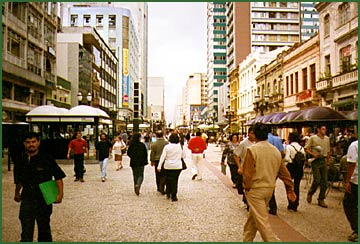
"But what may not be as easily transferable is the will to change, the political commitment, and the leadership that Curitiba has enjoyed over the past 25 years."
Stephen Leahy is a freelance writer specializing in science, the environment and agriculture. Written April 2002
| Return to Top
|
| Articles Archive
| About Our Times |